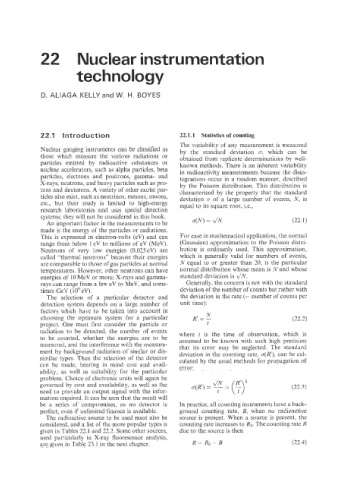Page 534 - Instrumentation Reference Book 3E
P. 534
u~lear instrumentatio
technology
Q, ALIAGA KELLY and W. H. BOYES
2 2 .?I I ntrodw ction 22.1.1 Statistics of counting
The variability of any measurement is measured
Nuclear gauging instrumeii~s can be classified as by the standard deviation CT, which can be
those w~hicl~ nieasure the various radiations or obtained from replicate determ~nations by well-
particles emitted by radioactive substances or known methods. There is an inherent ~ariabi~i~y
nuclea~- accelerators, such as alpha particles, beta in radioacti~~ty measurements because the disiii-
particles, electrons and positrons, gamma- and tegrations occui- in a random manner, desc~be~
X-rays, neutrons, and heavy particles such as pro- by the Poisson distr~bution. This distribution is
tons and deuterons. A variety of other exotic par- characterized by the property that the standard
ticles also exist, such as neutrinos, mesons, muons, deviation (T of a large number of events, N. is
etc., but their study is limited to high-energy equal to its square root. i.e.,
research laboratories and uses special detection
systems; they will not be considered in this book.
An important factor in the measurements to be
made is the energy of the particles or radiations.
This is expressed in electron-volts (eY) and can For ease in mathematical application, the nornial
range from below 1 eV to millions of e%’ (MeV). (Gaussian) approximation to the Poisson distri-
Neutrons of very low energies (0.025eV) are bution is ordinarily used, This approximationl
called “thermai neutrons” because their energies which is generally valid for numbers of events,
are comparable to those of gas particles at normal N equal to or greater than 20, is the particular
temperatures. However, other neutrons can have normal distribution whose mean is N and whose
energies of 10 MeV or more; X-rays and gatnma- standard deviation is JN.
rays can range from a few eV to MeV, and some- Generally, the concern is not with the standard
times G~V ClO’eV?. deviation of the timber of counts but rather with
The selection of a ~art~cuiar detector and the deviation in the rate (= number or counts per
detection system depends on a large number of unit time):
factors which have to be taken into account in N
choosing the optimum system for a particular R’ = - (22.2)
project. One must first consider the particle or t
radiation to be detected, the number of events where t is the time of observation, which is
to be counted, whether the energies are to be assumed to be known with such high precision
measured, and the interference with the measure- that its error may be neglected. The standard
ment by background radiation of similar or dis- deviation in the counting rate, u(R’), can be cai-
similar types. Then the selection of the detector culated by the usual methods for propagatioii of
ca.n be made, bearing in mind cost and avail- error:
ability, as well as suitability for the particular
problem. Choice of electronic units will again be
governed by cost and availability, as well as the (22.3)
need to provide an output. signal with the infor-
mation required. It can be seen that the result will
be a series of ~o~~~pro~ses~ as no detector is In practice, all co~ting ~nstr~ment5 have a back-
perfect, even if ~~~~i~ited available. ground counting rate, 3, \nihen no radioactive
is
finance
The radioactive source to be used must also be source is present. When a source is present, the
considered, and a list of the more popular types is counting rate increases to Ro. The counting rate R
given in Tables 22.1 and 22.2. Some other sources, due to the source is then
used particularly in X-ray fuorescence analysis,
are given in Table 23.1 in the next chapter. RzR0-B (22.4)

